It’s called a quasquicentennial. For those unfamiliar, it’s literally an invented term for an institution celebrating its 125th anniversary. As you can imagine, only so many golf clubs in the United States have reached that milestone. But in Massachusetts, five clubs spread out across the state — Meadow Brook Golf Club, Northampton Country Club, Oakley Country Club, Sharon Country Club, and Tatnuck Country Club — have reached another distinguished anniversary year in 2023. To recognize this feat, Mass Golf has profiled each club and chronicling how their historic grounds have made an impact on the golf community, both in the past and present.
It’s been said that Donald Ross has been Oakley Country Club’s gift to America. When the legendary golf course architect first came to the United States, Oakley gave him his first job as a club professional. From there he traveled to places like Pinehurst (NC) and Essex County Club, followed by more than 400 courses nationwide he or his firm either laid out or redesigned after that.
Still Ross’ true roots in the U.S. began at Oakley. It’s a classic layout with brilliantly routed fairways stretching across 88 acres atop historic Strawberry Hill, Watertown’s highest point, offering sweeping views of the surrounding cities. Founded at its current site in 1898, Oakley’s course is considered the first 18-hole golf layout in Massachusetts.
Ross’ name is far from the only one that carries weight when it comes to those associated with Oakley. From state and national champions such as Edith Baker, Harriott Curtis, Fred Wright, and Mike Ohanian, to U.S. Presidents Theodore Roosevelt, Franklin D. Roosevelt, and John F. Kennedy (all Harvard collegians), they help play a part in the club’s remarkable legacy.
As a founding member of both the Women’s Golf Association of Massachusetts (WGAM) and Massachusetts Golf Association (MGA), since merged to form Mass Golf, Oakley’s story is inextricably linked to the story of golf in Massachusetts.
“The membership has an above average respect for the history,” said Dan Mee, Oakley’s club historian, who added that Ross brought tremendous pride to the club. “People are cognizant that many clubs didn’t make it this far, and there were tremendous challenges along the way. Our predecessors made smart decisions, and we’re thriving because of it.”
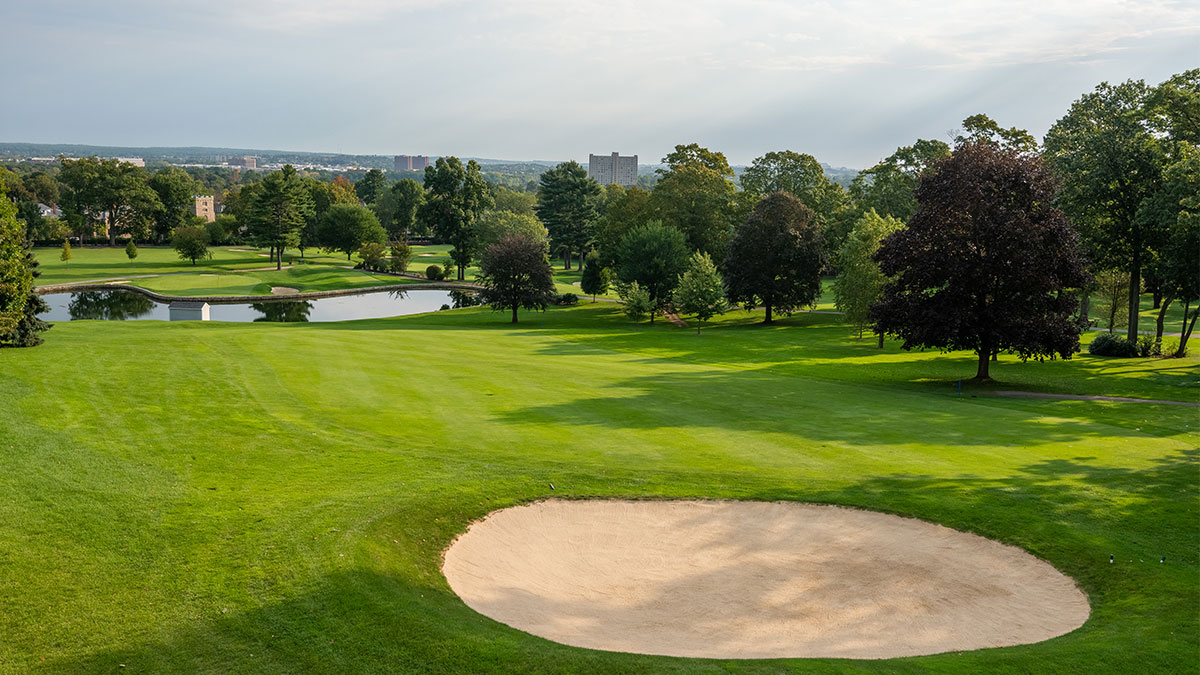
Before moving to its current location, Oakley’s story began in 1895 with the establishment of the Cambridge Golf Club on the Adams estate. It was a nine-hole layout just south from the present course. One of the earliest mentions of the club was actually about its sheep, who were responsible for keeping the grass short in keeping with English tradition. One night, the club’s sheep were stolen and left in Watertown Square after the thief was spotted by a police officer. All but two were returned, but some were injured in the process.
In 1897, members of the club purchased the former Harrison Gray Otis country estate named “Oakleigh” together with its Charles Bulfinch-designed mansion as its new clubhouse. A year later, the club incorporated as The Cambridge Golf and Country Club and contracted the services of Scotland’s Willie Campbell. His impressive work included The Country Club, Myopia, Essex, as well as Franklin Park, the second-oldest municipal golf course in the U.S. Campbell set about designing Oakley, the second-oldest 18-hole course in New England after Newport Country Club (RI). The course at present-day Oakley opened in September 1898, and since November 1898, the club has been known as The Oakley Country Club.
That same year, Harvard Professor Robert W. Willson, an Oakley grounds committee member, visited Scotland and recruited Ross, then 25, from the Dornoch Golf Club to come to Oakley. Ross’ first job was a club maker and instructor, and later a greenskeeper. The club acquired more land, but when Campbell died at age 38 in 1900, the club turned to Ross to carry out the first of three redesigns of the course. What resulted was much of what Oakley is today: A classic, tight, park layout: complete with the challenging bunkers, numerous “cops” and fast, undulating greens for which he is now universally renowned.
Golf was so lucrative to Ross, winner of the first Mass Open in 1905, that he sent $2,000 to his mother in Scotland to add a second story to the family home, which was later named the “Oakley Cottage.”
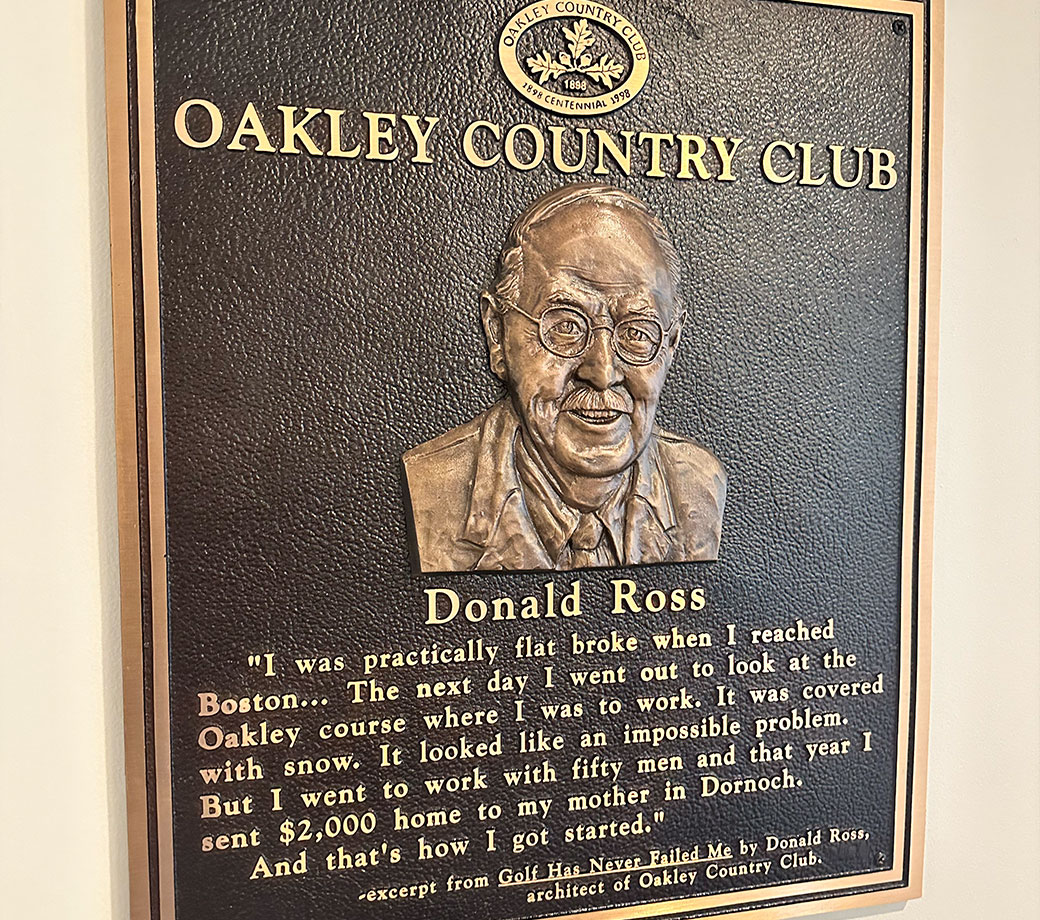
“When he left Essex in 1914, Oakley gave him privileges at our course, which is unheard of for a former employee,” Mee said of Ross. “That’s how respected he was. In a letter he gushed about his relationship with Oakley. They got him many of his first contracts.”
Around the same time, some of America’s first female golfers played Oakley. In 1900, representatives from The Country Club, Brae Burn Country Club, Concord Country Club and Oakley Country Club converged to form the Women’s Golf Association of Boston (later Massachusetts). Throughout the spring and summer, interclub matches were played amongst the clubs (present day Spring Team Matches), and by October, Oakley had accumulated the most points and was selected to host. Grace B. Keyes of Concord defeated Harriott Curtis in the final match, giving her honors as the first amateur golf champion of Massachusetts.After acquiring more land in 1910, two holes were replaced by Ross, and the routing has remained unchanged since then. “The members never went cheap on the golf course,” Mee said. “It’s nice to see it from its earliest days.”
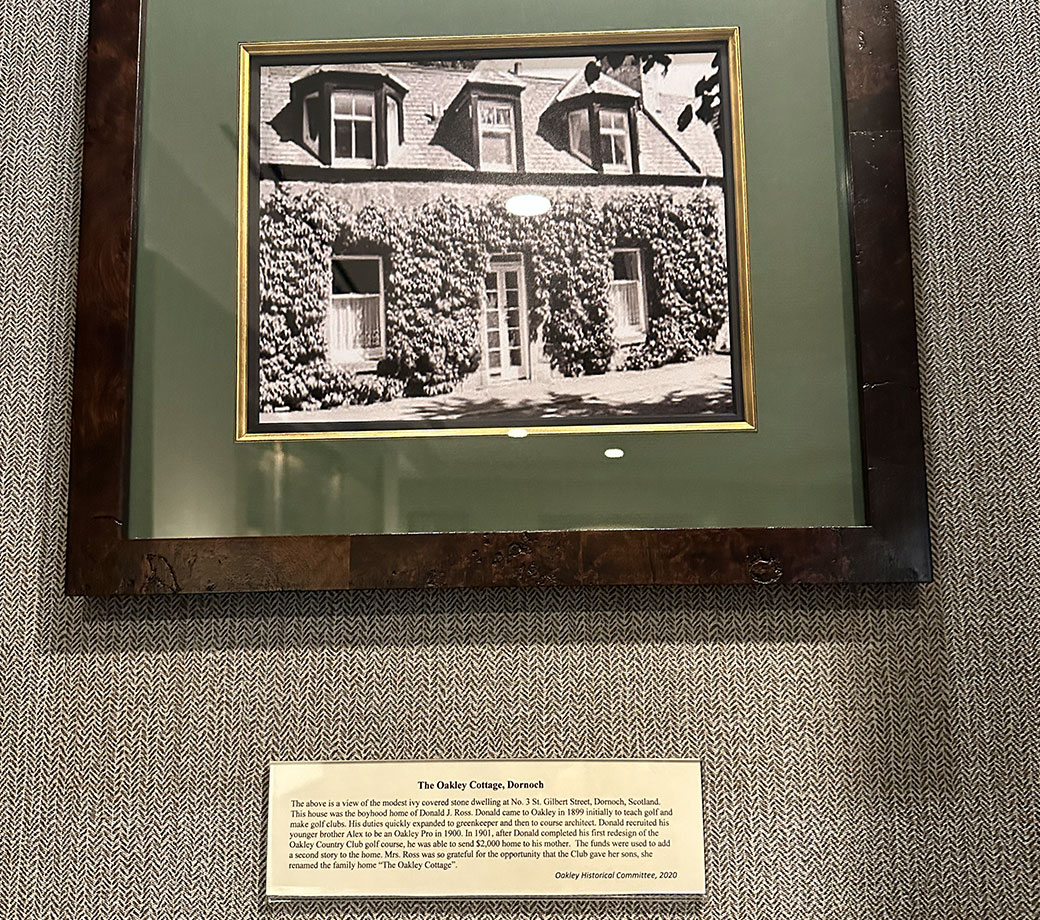
Oakley’s legacy of championship-caliber members dates all the way to 1896 when founding member Joseph Gilbert Thorp, a Boston lawyer, finished runner-up in the 2nd annual U.S. Amateur Championship at Shinnecock Hills, N.Y.
Years after Ross arrived in America, his brother Alec was invited to work at the club, and in 1907, he won the U.S. Open at Philadelphia Cricket Club. After being tied with club member Mike Brady through Round 1, Ross surged into the lead, and his consecutive 76s in the final two rounds was enough for victory. Ross also won the 1912 Mass Open at Oakley.
Being a founding member of the WGAM, naturally some of the state’s top talent flocked to Oakley. Nantucket-born Pauline McKay became the club’s first national champion when she won the 1905 U.S. Women’s Amateur at Morris County Golf Club in New Jersey.
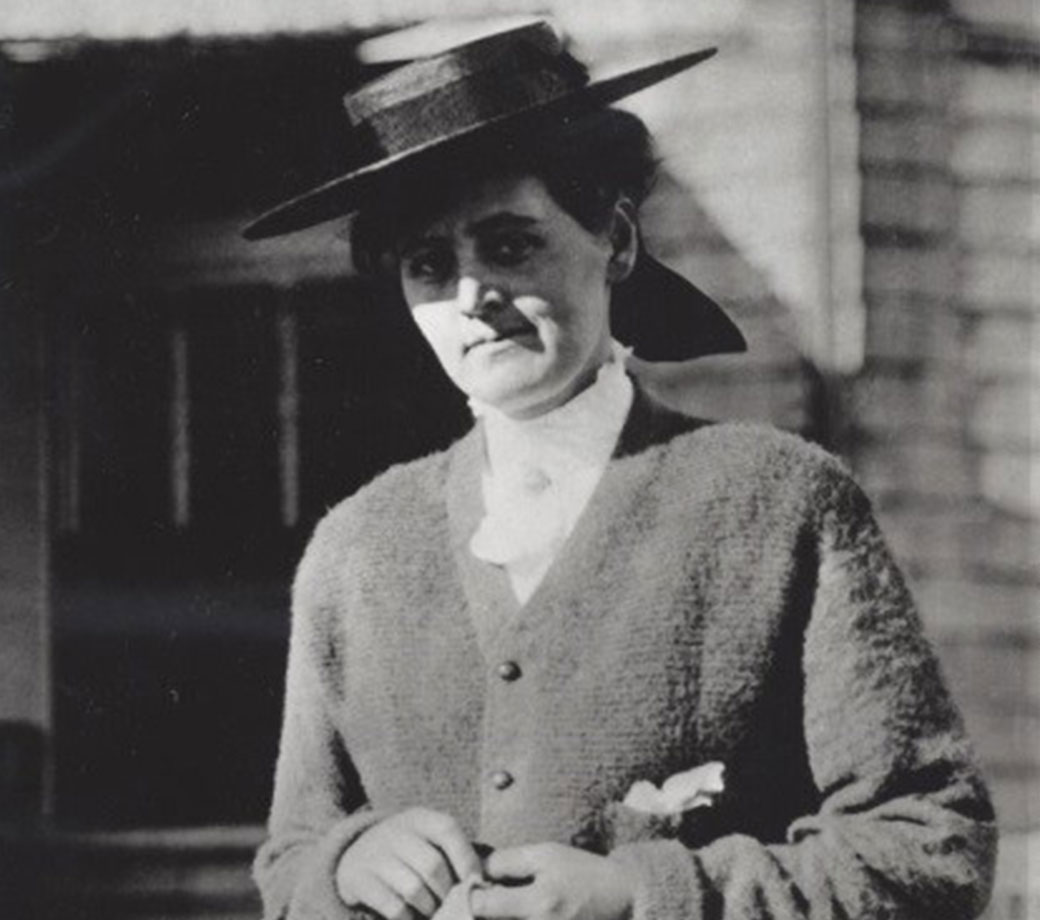
“I think golf must be a sixth sense with me,” she told an interviewer after that victory, “I love it so, and it came to me so naturally; but I do thoroughly believe no woman can become a proficient player without taking excellent care of her health… and I think the spirit of competition a woman feels in playing with men is a great aid in strengthening her game.”
Harriott Curtis won the title in 1906 at Brae Burn, and then fellow member Katherine C. Harley took home the title in 1908 at Chevy Chase Club (MD). When she won her second title in 1914 at Nassau Country Club (NY), she became the first woman to win it both before and after getting married.
As mentioned previously, Oakley has had its fair share of presidential sightings, whether before or during their terms. One in particular stands out in 1905 when Teddy Roosevelt visited the club as part of his Harvard reunion (Class of 1880). During a photo opp, a photographer asked if he’d look down . His reply, “You don’t want me to appear bashful do you.?” (He took them off instead).
Continuing with the Harvard tradition, individuals such as Bobby Jones and John F. Kennedy both played Oakley regularly as members of the golf team.

Among its many statewide championships hosted, Oakley also held the first Mass Junior Amateur championship in, won by Raymond Ouimet, Francis Ouimet’s younger brother.
Years later a young Oakley caddie named Fred Wright transformed into one of the most iconic figures in the golf community. Wright became the only seven-time winner of the Massachusetts Amateur, with those victories spanning from 1920 to 1938. At age 58, he became the oldest finalist in event history. Wright also won consecutive Massachusetts Junior Amateur titles in 1916-17, and lifted the United States to victory at the second Walker Cup in 1923 when he rallied from 2-down with 3 holes remaining in his final match at St. Andrews. Wright also captured the 1956 U.S. Senior Amateur. Wright unexpectedly, though almost fittingly, died on the golf course.
Another iconic Oakley champion is Mike Ohanian. While serving as club president in 1968, Ohanian won the Mass State Amateur at Concord’s Nashawtuc Country Club. After taking a 4-up lead through the first 18, the cigar-chomping standout made an 18-footer on the 35th hole of the match to capture a 2-up victory.
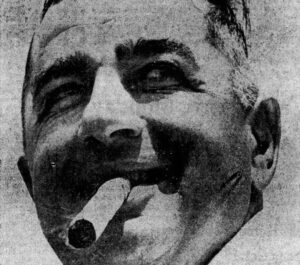
A praiseworthy achievement of Oakley is that you can play the course just about how it was intended when Ross perfected the layout more than a century ago. The course stretches out to hair more than 6,000 yards from the back tees, and can be played as a par 70 or 71, depending on where the tees are placed on the 10th hole, which runs parallel to Belmont St. Nearly the entire front nine plays on the west-facing part of the course, while the clubhouse facing east looks over much of the back nine.
There’s plenty to defend par on each hole. Hardly is there a flat hole, or flat lie for that matter, on the property. The contours of the putting greens also throw players for a loop. To many members, putting on “Oakley greens” is an experience on its own. It gives one the feel of classic golf, where a premium is placed on accuracy over distance.
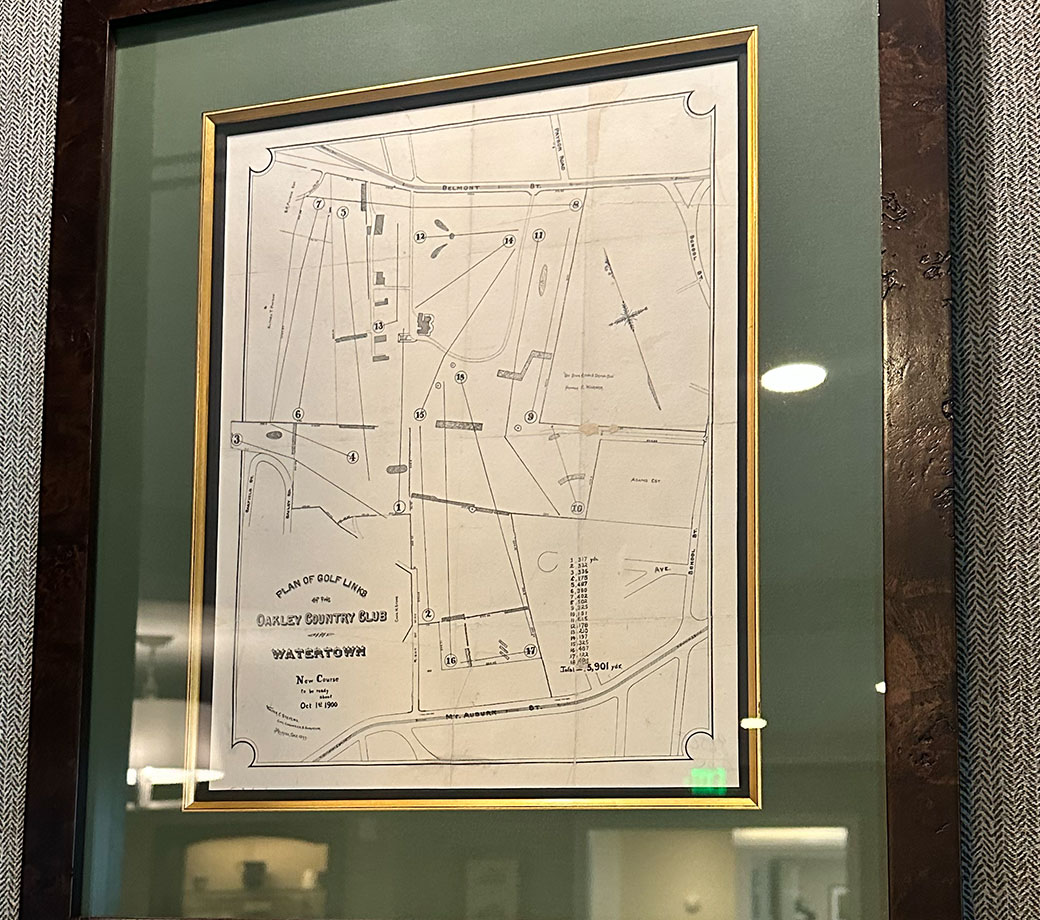
While it’s the same Ross routing, there’s one particular feature he had nothing to do with. In the 1980s, water rates doubled and even tripled, and with no water source on the course at the time, the current rates were unsustainable. Though adding a water hazard wasn’t ideal (Mee said Ross considered it an unforgiving hazard), an irrigation pond was added in 1994 at the the base of the 15th hole, replacing a gigantic bunker that used to defend shots that came up short. Other than the tee shot on the 16th, water doesn’t come into play anywhere else on the course.
However, what stands now are too unforgettable par-3s, a long, uphill shot on 14 with bunkers lurking on the right side, and the downhill 15th that makes you feel like you’re king of the hill, even though it’s not the highest point on the course.
In 2003, the pond was named Shea’s Pond after Dr. Daniel F. Shea, a former club president, board member, and historian in his 40-year tenure at Oakley.
Aside from that, there’s shots in every direction, from extreme downhill approaches where you can run it onto the green, to uphill shots that require some creativity, golfers have found this layout every bit as challenging for the past 125 years.
Soon it will test some of the state’s best men and women when Oakley hosts the first two rounds of the Ouimet Memorial Tournament from July 26-27. Those who make the cut will play the final round at Woodland Golf Club.
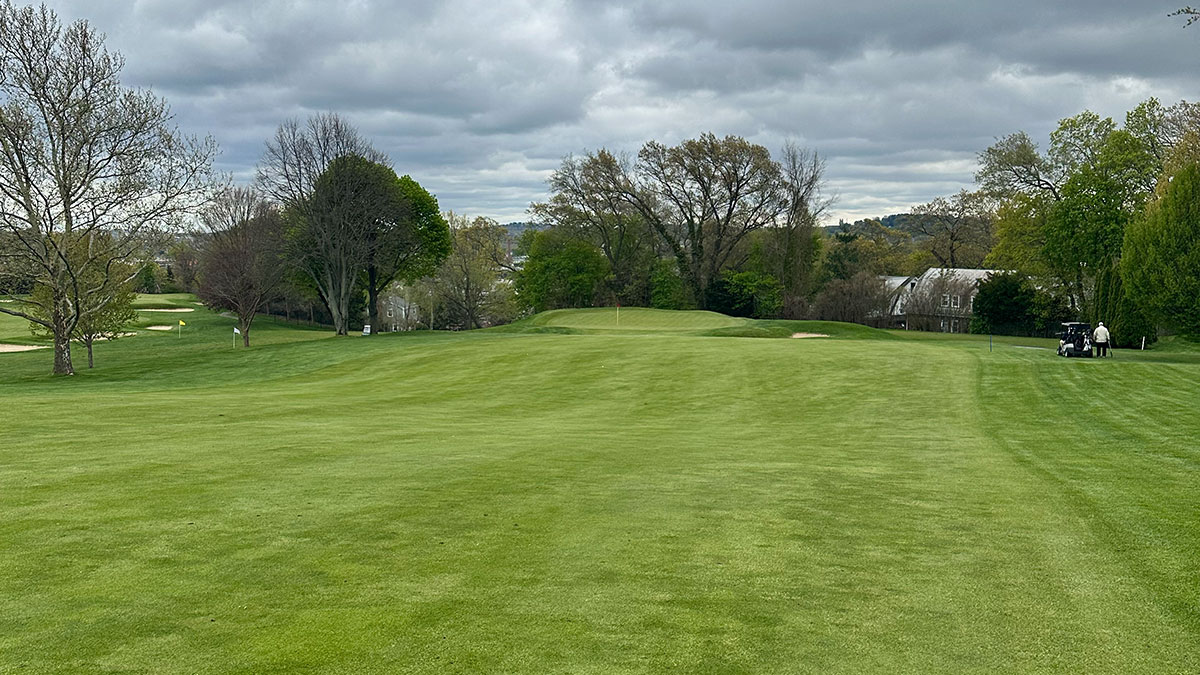
The original Oakley Clubhouse was tragically lost in a 1962 fire, including some of its most historic items. However, it was replaced by a new clubhouse, remodeled in 1998 to be faithful to the lines of the original Bulfinch building.
The club’s admiration for Ross continues today with the Donald Ross library inside its building. During the club’s 1998 centennial, Ross’ only daughter, Lillian Ross Pippitt, attended the dedication of the library, unveiling a 6-foot tall portrait off Ross in his 30s. It immediately catches ones eye when walking into the library from the front.
Items inside include Ross’ very first course designs plans, as well as artifacts from the time period, such as old-school golf balls, trophies, and more. There’s also a photo of his home in Belmont with his family. A mashie made by Ross is also on display in the clubhouse.
“Everything in that room has been donated or acquired at auction to achieve the authenticity of that room,” Mee said. “It took hard work over decades to rebuild and display. It’s respectful and educational.”
Last fall, the club celebrated what would’ve been Ross’ 150th birthday. He is buried in Newton next to his wife, Janet, his daughter, Lillian, and her husband, Richard. It’s an ongoing tribute to the man who forever shaped Oakley’s future and that of many other clubs.
As Mee puts it: “The club respected him, encouraged him, and he returned the favor 10-fold.”

It’s been referred to as one of the best golf courses you probably haven’t heard of. That notwithstanding, Worcester’s Tatnuck Country Club, which is tucked away in the northwest corner of New England’s second largest city, is certainly one of the best gems in Massachusetts.
The club is located in the neighborhood of Tatnuck, which is translated from ‘Tataesit’ which means “at the great hill” in Nipmuck language. The hillside club was established in 1898 by members of Quinsigamond Boat Club “for the purposes of establishing a country club.”
Over 125 years it has developed into a comfortable retreat for members and guests. The 9-hole Donald Ross layout maintains much of its classic flair and remains a fair test for golfers of all levels. The club also takes tremendous pride in its amenities. In addition to expansions to its “prairie-style” clubhouse, the club’s features include a driving range, short game area, swimming pool, tennis and paddle-platform tennis courts, and a basketball court, adding to the family-friendly nature of the club.
Though Tatnuck has always been a small club of less than 300 members, it’s been home to some of the biggest names in Massachusetts golf history – most notably Paul Harney, a 6-time PGA Tour winner and member of the Massachusetts Golf Hall of Fame.
There’s even been a world record set here, adding illustrious history to Worcester’s oldest golf club.
“A lot of our members take pride in the fact that we were one of the earliest golf clubs in America,” said Tatnuck’s head golf professional P.J. Breton. “We’d love to continue to represent Worcester as the club continues to grow as it has. A lot of our members owns restaurants and businesses around the area, and they want to be heavily involved in keeping this a great place to be during golf season and beyond.”
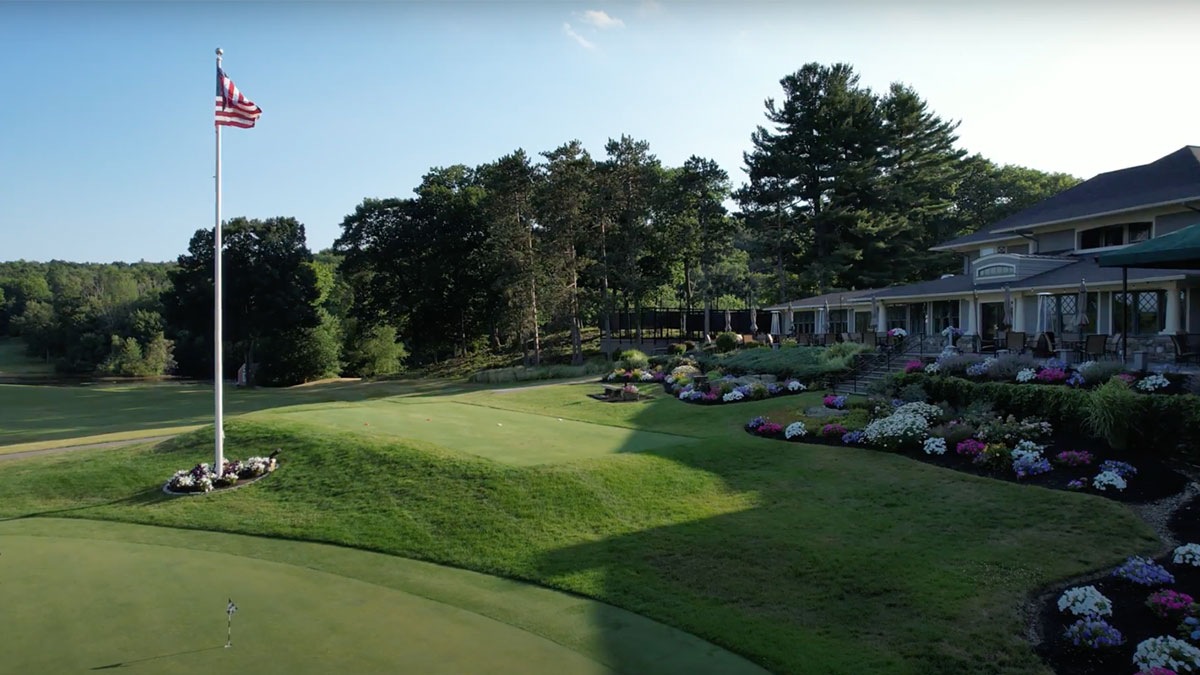
Willie Campbell, a Scotsman who became one of America’s great early golf architects, laid out the original course routing. Prior to arriving at Tatnuck, Campbell was involved with important projects such as designing the first nine holes at Essex County Club and Myopia Hunt, as well as the expansion of The Country Club, where he was head professional.
Campbell’s rudimentary 9-hole layout stretched about 2,300 yards and ran largely east to west, making the sun a nuisance for those playing the course particularly in the afternoon. One of the few lasting remnants of the original layout is the current 4th green, a small circular area defended by a deep fairway bunker and a greenside bunker on its right.
The current routing is largely a north-south orientation (about 3,000 yards). Despite its location on the hillside, it’s certainty a comfortable course to walk if one chooses.
The original layout didn’t last long as the club was able to retain Donald Ross, who was brought in from 1912-1913 to reconstruct the layout and introduce much of the bunkering and green shapes seen today. Ross maintained a presence in Worcester, living less than miles down the road in Tatnuck Square during the World War I years. He would go on to design Worcester Country Club, which hosted the 1925 U.S. Open and the first Ryder Cup in 1927.
The first five holes at Tatnuck now play along the outer perimeter of the course. The opening drive from alongside the clubhouse offers a beautiful view of the landscape, however club selection is crucial as a creek and large pond on the right (just one of two water hazards on the course) lurk just about 230 yards ahead. In fact, when 1913 U.S. Open champion Francis Ouimet played Tatnuck for the first time in June 1915, his 1st and 10th tee shots into the water. In Ross style, the green slopes back to front making for a difficult approach.
After playing into a downhill par-3 into another undulated green, two of the next three holes are short par-4s (3rd and 5th), both excellent for match play competition. The 3rd (298-yards from the farthest tees) has large bunkers that swallow up wide tee shots for the average player, while the 5th is even shorter at just 257-yards max with two greenside bunkers guarding the front. According to former head pro Tim Bishop, Ryan Harper of Shrewsbury is the lone player of record to have aced the 5th hole.
The most challenging stretch awaits on the final three holes, a trio of lengthy holes along narrow, tree-lined fairways but with few hazards to manage. From the white tees, seven plays 396 yards, eight 447 yards and nine 405. From the farthest tee behind a pond, the 8th can play as a 491-yard par-5.
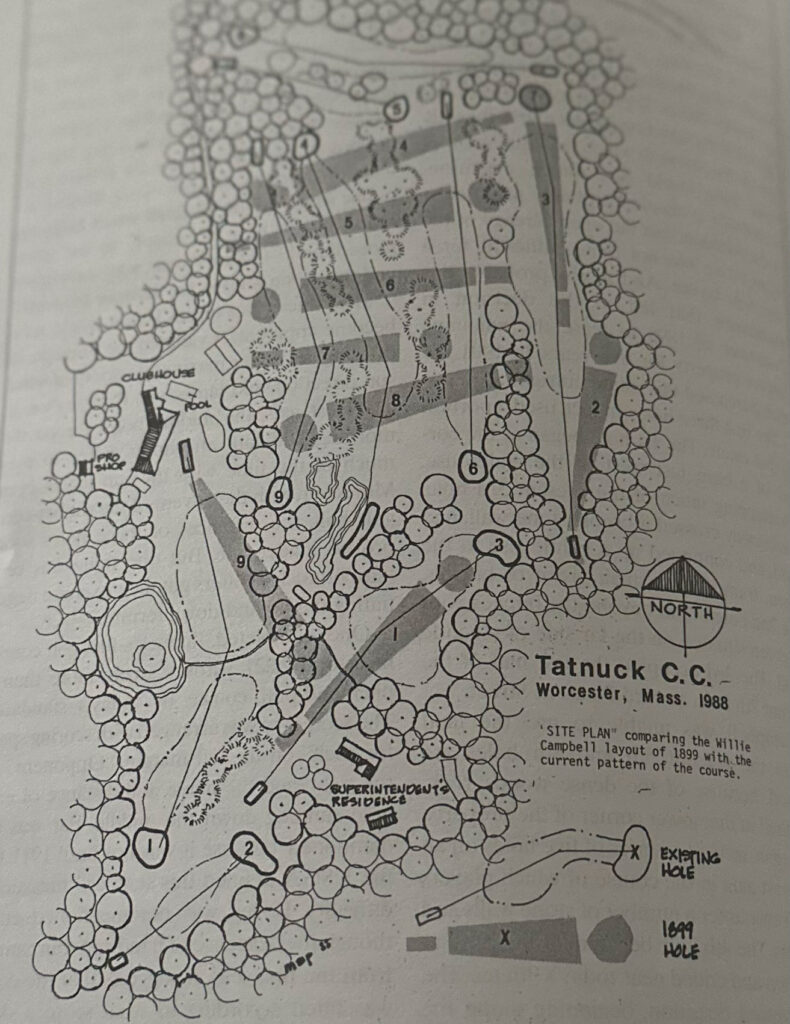
Like many classic Ross courses, green speeds and pin locations are key to defending par.
“You can still make it difficult for the long hitting player,” Breton said. “But you have to be creative. A short hitter who has a strong wedge game can have good scoring opportunities. The greens are very fast and have subtle breaks. With less trees, any high gusting winds, will make keeping it on the green difficult.”
Geoffrey Cornish came in about 40 years ago to add some bunkering to the course, a new green on the 2nd hole, and expanded the length of the 9th hole, as it now finishes closer to the clubhouse where the practice green used to sit. Cornish said of Tatnuck, “Its Quaker style is beautiful due in part to the plainness and simplicity that make it one of those courses recognized elsewhere in the national as New England golf architecture.”
Within the past couple years, the club has consulted with Ross expert Bradley Klein and acquired the services of architect Matthew Dusenbery to restore Ross elements to the course. Though Ross never left behind design plans, the duo has aerial photos from 1934, 1948, 1960, plus modern day images to compare. The goal is to address nine basic priorities in phased approaches. In addition to irrigation and drainage, the most notable items include tree removal to open up sight lines and improve turf health; widening fairway lines; and expanding greens, many of which have been rounded off. They also reintroduced the deep fairway bunker on the 4th that requires strategic decisions on approaches into the green.
Restoration at Tatnuck CC yesterday with @Dusenberry and superintendent Craig Resley to open up entrance to 4th green and reposition approach bunker entailed intense labour of cutting, lifting, moving 50-80 pound sod strips. I am tired today. pic.twitter.com/RCwcSYSdTi
— Bradley S. Klein 🇺🇦 (@BradleySKlein) April 28, 2022
“It’s a lovely place, nice piece of the land,” Klein said of Tatnuck. “These changes create alternatives for shot making. So far the membership seems happy, and they’re seeing how this work is opening things up.”
“This will add to the playability of the course and will give myself and [superintendent Craig Resley] an opportunity to have more pin locations for tournaments,” added Breton. “This will give players many different looks and spots they have never played from. It’ll be interesting for invitational or club championships here.”
Tatnuck used to have more land but never expanded to 18 holes. In 1944, the city of Worcester acquired through eminent domain 35 acres of property to build the Worcester Regional Airport, which now overlooks the golf course. Day by day, planes of all sizes cruise over the historic golf course. Once in a while, the National Guard will practice ‘touch-and-go’s” at the airport.
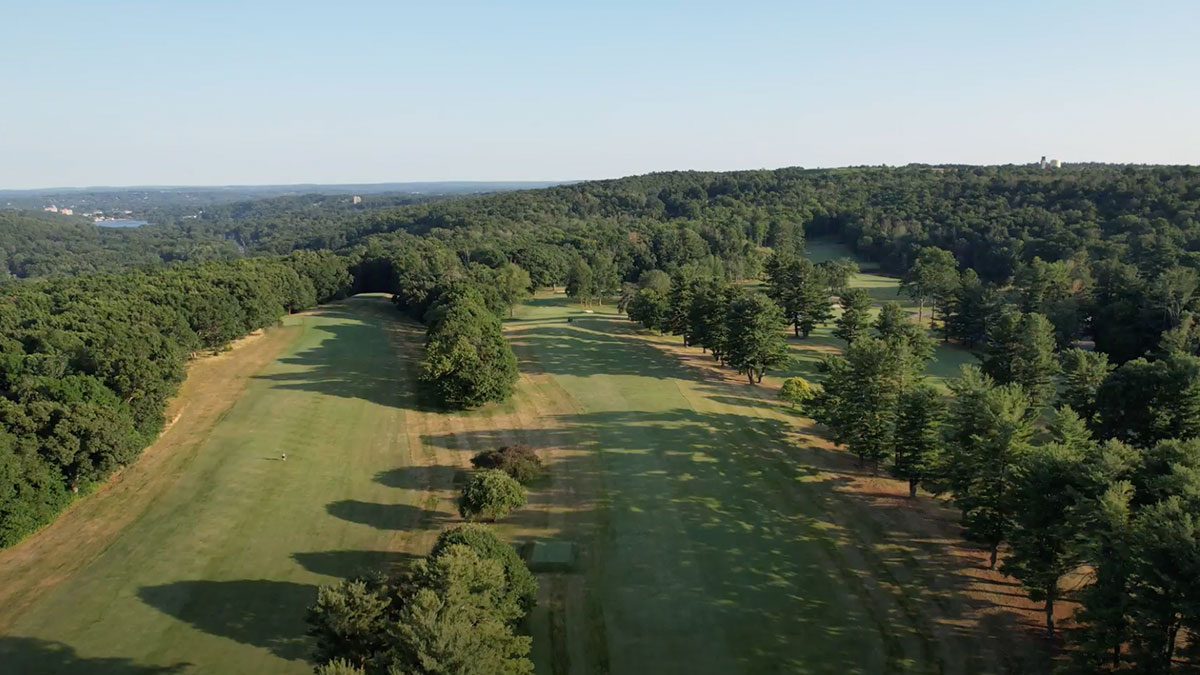
Sanford Kingsbury Sterne emerged as Tatnuck’s first standout golfer. He was the club’s lone scratch golfer by 1913, making him one of the state’s top amateurs. He first rose to prominence by winning three Worcester country championships and came up just shy of qualifying for the 1913 U.S. Open at The Country Club. He moved to the West Coast to pursue a career in advertising, but sadly upon his return passed away at the untimely age of 32. However, he’s still heralded for his skill, sportsmanship and humble nature.
In 1939, Byron Nelson visited Tatnuck on the heels of his Mass Open victory at Worcester Country Club. Playing in a best-ball exhibition with Willie Ogg, Harold “Jug” McSpaden, and then-Tatnuck golf pro Arthur Gusa, Nelson thrived on the short but tight layout, shooting 67 to match the course record. With a $25 prize for a new course record on the line, Nelson had a 12-foot putt to break the record, but it came six-inches shy of the cup.
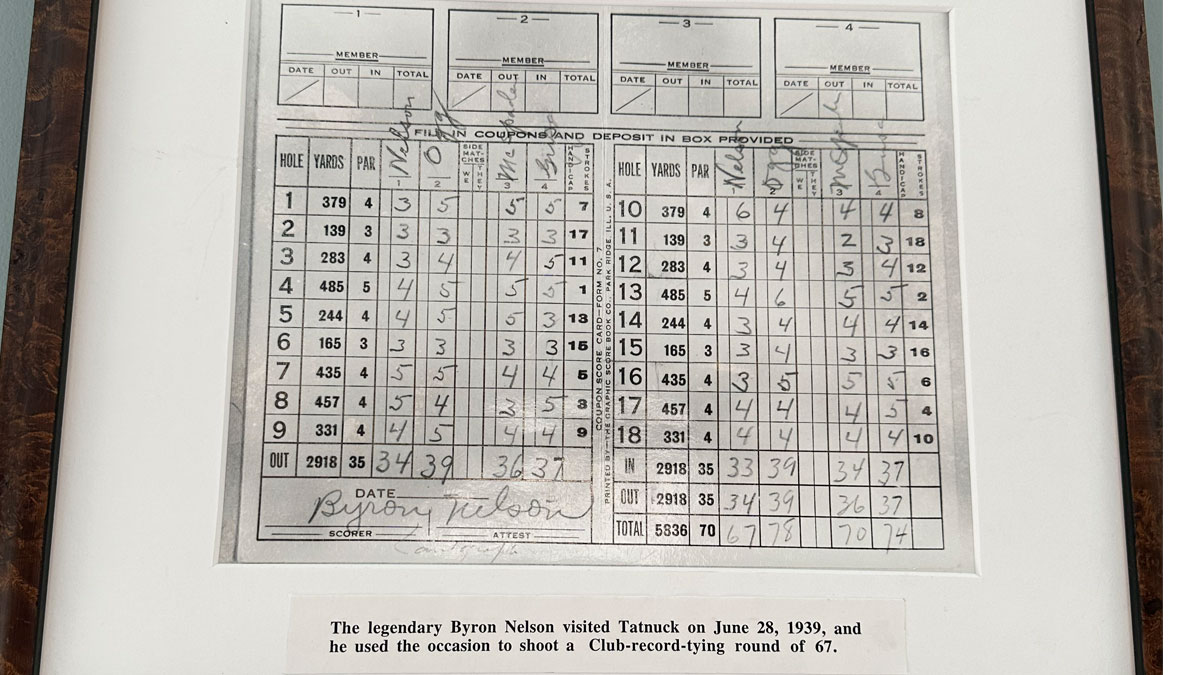
About two decades later, Worcester native and Tatnuck member Deborah Verry emerged as a standout on the amateur golf scene and later became a pioneering woman in the field of American espionage. She became the first Massachusetts player to win the North & South Women’s Amateur in 1935 and won the Mass Women’s Amateur in 1937 and 1940. In the lead up to World War II, Verry was one of the first to sign on with the Massachusetts Women’s Defense Corps, which formed in April 1941 to prepare women to serve as volunteers in local Civil Defense agencies. Verry headed up a mobile unit, and eventually joined the Navy through WAVES (Women Accepted for Volunteer Emergency Service). In 1948, Verry joined the newly-formed CIA and was assigned to the Center for the Study of Intelligence (CSI) branch.
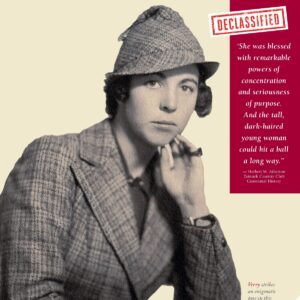
Tatnuck’s longtime professional Arthur Gusa (1936-1978) once referred to Paul Harney as the finest golfer Tatnuck has produced. It’s hard to argue otherwise today. Russell Paul Harney grew up in a house on Robinson Road adjacent to Tatnuck’s driveway and was introduced to the game by caddying at the club. After graduating Holy Cross and serving as a Navy Officer in the Korean War, he returned home and launched a successful career that included six PGA Tour victories, four top-10 Masters finishes and a fourth-place finish in the 1963 U.S. Open at The Country Club.
Toward the end of Harney’s life, then-pro Jack Gale arrived at the course and saw Harney standing alone by the pro shop. He offered to drive Harney around to see the course, which Harney hadn’t seen in decades. Harney shared stories of his early days when he’d go out after dark and practice putting. “His wife told me after that day, you can’t imagine how much that meant to him,” Gale recalled. “He was a terrific man, and I’m glad I got to know him a bit.”
Gale certainly created plenty of accolades for himself, as he became head pro in 1982, a role he held for 29 years. The Worcester native (Burncoat High & WPI graduate) modernized the position, improving communications methods as well as streamlining and introducing tournament formats. The educated and ambitious pro wrote his thesis on “mental dimensions of golf” to become a PGA Master Professional, the 38th individual in the country to earn the title.
Gale’s wife Mary also brought high praise for Tatnuck. Perhaps top among her accolades is winning the 1996 Mass Women’s Amateur, but she also has state victories in the Women’s Mid-Amateur (1986), Women’s Stroke Play Championship (1987), Women’s Senior Amateur (2010, 2012), and the Endicott Cup (1994, 2013), plus more than a dozen Mass Mother-Son victories. Though she’s no longer a member of Tatnuck, she set the bar high for female golf at the club.
Among the events introduced in the Gale era was the “Beat the Pro and Wife” competition where married members would play with their full handicaps and try to beat the Gales in a better-ball event.
In the 1970s and 1980s, Peter Bennett and Bruce Carter emerged as the club’s leading men’s golfers. Combined they won all but three club championships in those two decades. Carter used to own the course record at Tatnuck with a 63, before Shrewsbury’s Eddy Black shot a 61.
The most recent standout to come out of Tatnuck is Tim Umphrey, who is pursuing a career in pro golf. Umphrey won a Division 1 state title at St John’s (Shrewsbury), followed by four years at UConn. In 2018, he teamed up with college teammate Jimmy Hervol to win the Mass Four-Ball. Back in 2019, Umphrey and Carter combined to win the Walter Cosgrove Four-Ball at Green Hill Golf Course, the city’s municipal golf course.
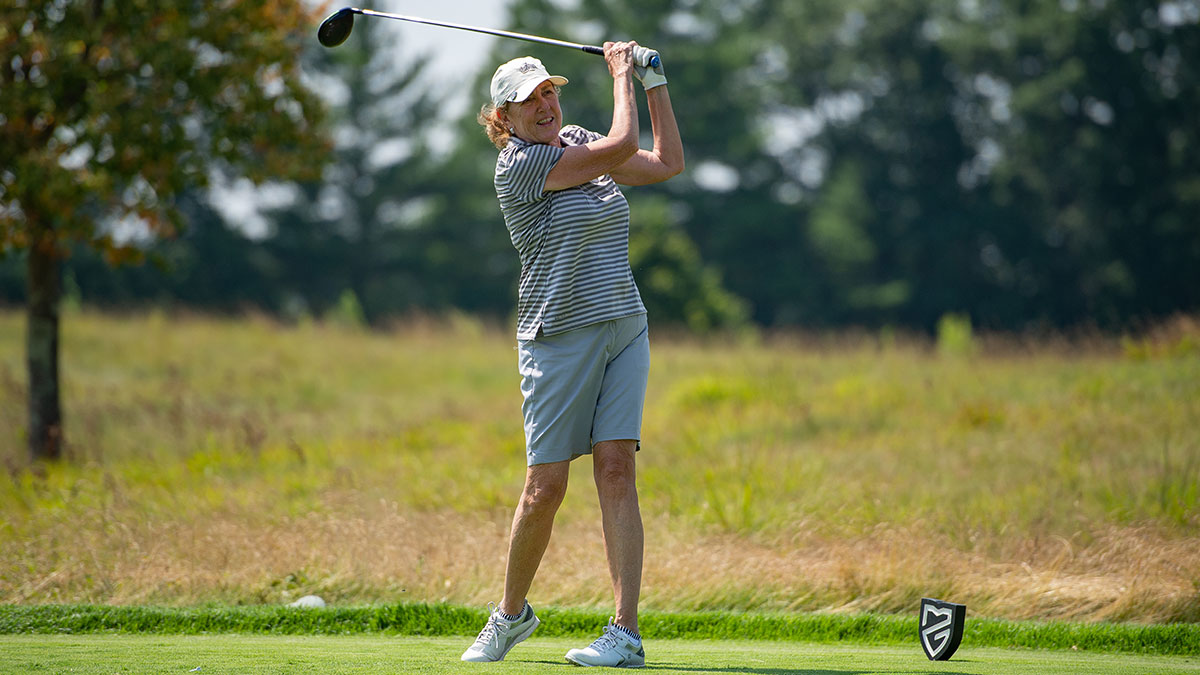
September 9, 1996, will always go down as a historic day at Tatnuck as a group of 99 (club pros and members alike) from across seven Central Massachusetts clubs gathered on a foggy and damp day to break the world record for fastest 18 holes played (1992 record, 9:37) on a course over 6,000 yards.
The group dubbed ‘The Lunch Brunch’ practiced several times leading up to the scheduled date but could never come close to the record time. But just before noon on September 9, the stars aligned. Witnessed by Bishop Daniel P. Reilly and Worcester Mayor Raymond V. Mariano, Mary Gale led off the group with well struck tee shots on the 1st and 10th tees, and the group got the ball around the first nine in 5:07. Amazingly their second nine was even shorter, as when the Worcester Country Club team made the final putt on the 18th, the clock read 9:28, a new world record.
“It was tough to get two good nine holes back to back. But after 10-12 tries, we did it,” then-Tatnuck assistant pro Keith Early told the press afterward.
More importantly, this effort raised about $20K for charity.
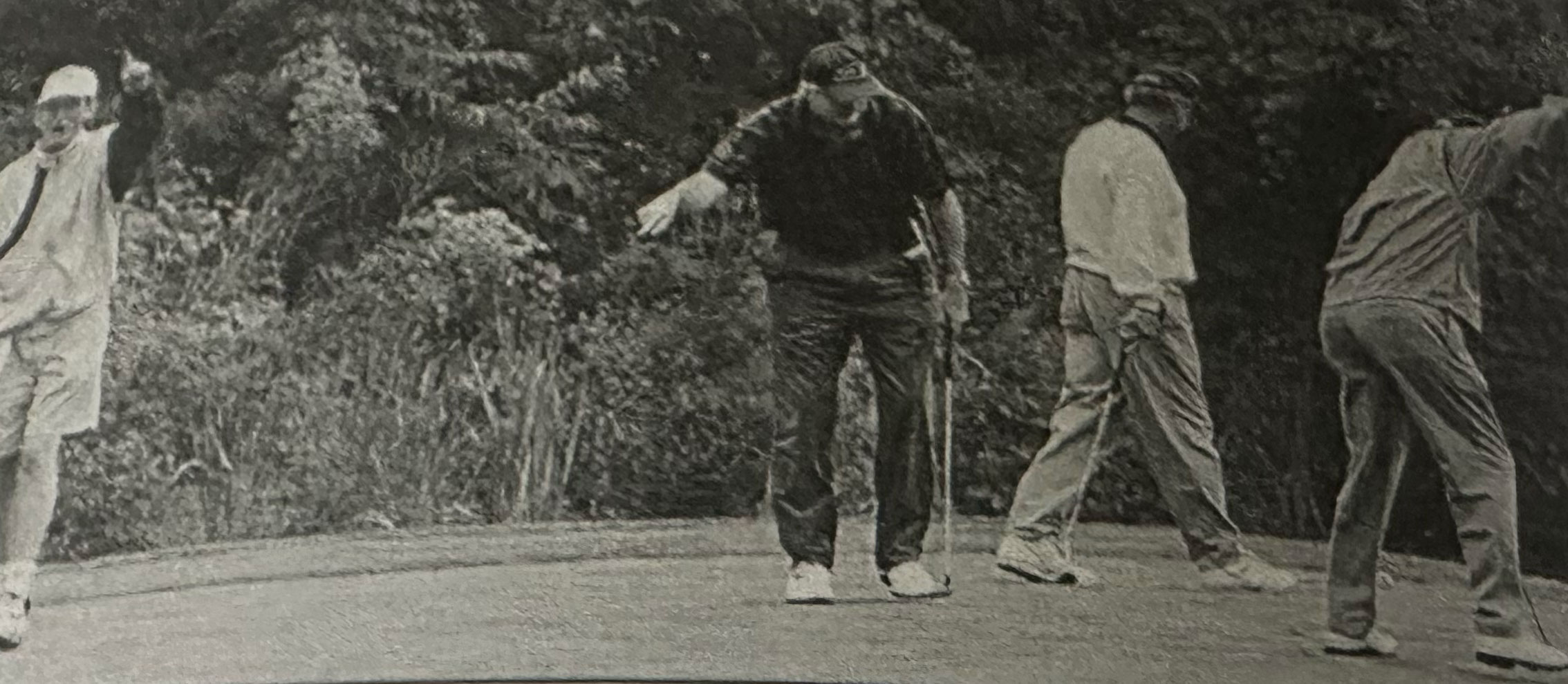
MODERN TIMES
Tatnuck has plenty in store to help celebrate its 125th anniversary this year.
First there’s its celebratory 125th logo, which tells the unique story of the club. Ryan Gabel designed a logo of a single propeller plane to recognize its proximity to the airport and the year 1898 to honor its establishment dates. There’s also a No. 9 nautical flag along the side to celebrate both the founders of the club and the nine holes on the course. The flat brim top to the plane pays homage to the brim of Donald Ross’ signature cap.
There’s also plenty of golf events in store, including the inaugural Worcester County Women’s Amateur golf tournament, designed to showcase the course to Worcester Country’s top female talent. (June 30-July 1; Handicaps 10.0 and below). In addition to its usual club tournaments, Breton also said the club will host the 125th anniversary double-shotgun tournament on September 9, with a gala to follow.
While there is still plenty of work underway to fully optimize the golf course within its surroundings, if you get an opportunity to play Tatnuck, you’ll get to enjoy a classic Ross course that has no doubt withstood the test of time.

The founders of Meadow Brook Golf Club had a simple goal in mind: Bring golf to the north Boston suburb of Reading for the townspeople to enjoy. By finding the right land at the right time and getting buy-in from the community, the club has remained on the same grounds for 125 years and now features arguably the most challenging standalone 9-hole golf course in Massachusetts.
Many rich stories have been written at Meadow Brook Golf Club. There has been strings of good fortune, such as Francis Ouimet helping put the course on the map by playing in a well-attended invitational just weeks after his sport-altering victory in the 1913 U.S. Open. And there’s been strings of bad luck, including four clubhouse fires in its history, most notably back-to-back ones almost exactly a year apart in 2020 and 2021.
Through it all, Meadow Brook has evolved successfully with the times, and carries a proud history with its facilities and membership.
“Meadow Brook is really a family club — a great golf championship golf course, wonderful tennis and racquet courts, and a vibrant pool membership with a very successful swim team,” said Marcia Brown, a longtime Meadow Brook member who won the women’s senior and women’s club championships in 2022. “Our brand new, state of the art clubhouse has now become the focal point for all members.”
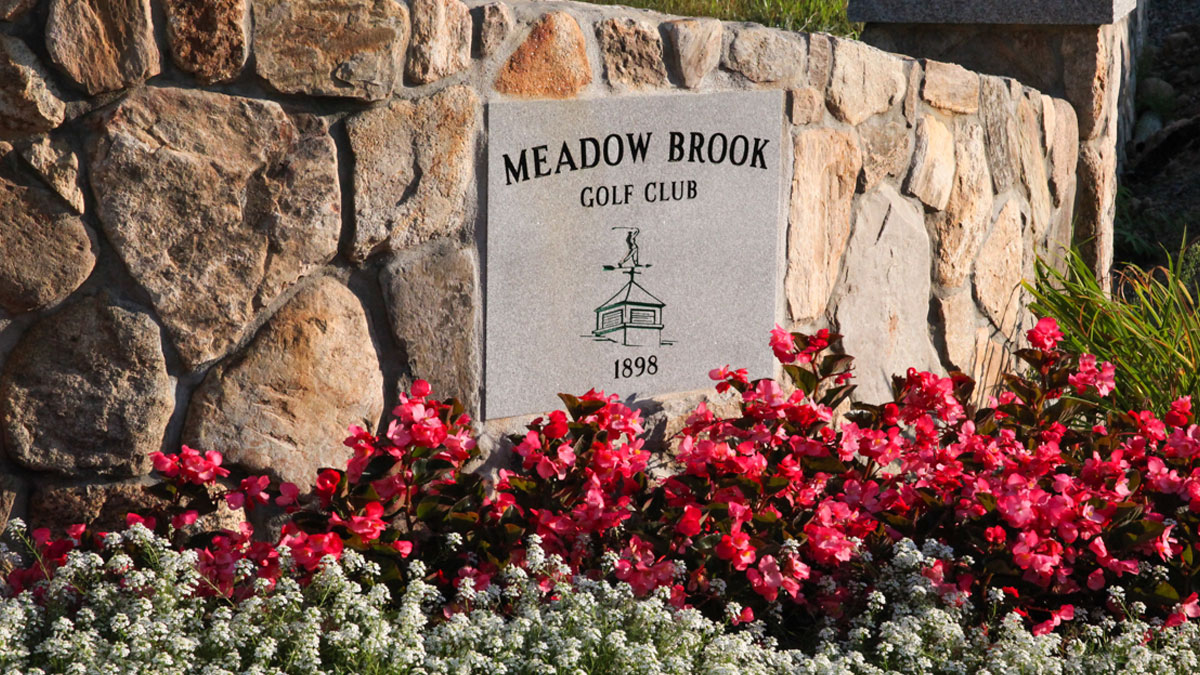
With length added periodically throughout its history, the course can be played anywhere from 4,750 to 6,870 yards. Its 74.4 top course rating puts it on par with iconic championship venues such as Brae Burn Country Club and The Kittansett Club. If that doesn’t convince you of its difficulty, take it from current PGA Tour pro Nicholas Lindheim, who once commented that the second hole from the championship tees is “a U.S. Open quality hole”.
The opening stretch certainty leaves an impression on golfers right away. The opening tee shot from a two-level tee box carries over Grove St. with beautiful mounding on the left and trees lining the entire right side. A fairway collection bunker on the right can collect errant shots, while the green is protected by a deep bunker on the left side.

The aforementioned second is the longest par-4 on the course stretching to 443 yards, and like the first, it has OB all along the right side. A small valley sits between the landing area, and once on the green, you need to stay below the hole, as the green slopes severely from back to front.
The third hole is a true 3-shot par-5 dogleg right with a large pine tree and three pot bunkers protecting the small green along the right side.
A wide-open tee shot awaits on 4th, followed by a par-3 that plays up to 70 feet downhill from tee to green. The other par-3, the 7th, also plays downhill but is surrounded by six bunkers, placing a premium on accuracy. The round concludes with a risk-reward L-shaped dogleg right back toward the clubhouse, with about 220 yards needed to clear the corner.
“Each hole on the course has its own character,” said Ron Rice, Meadow Brook’s general manager. “Having the two separate tee boxes, you play twice but get a different look. A right-to-left shot is favorable on those first three holes in particular.”
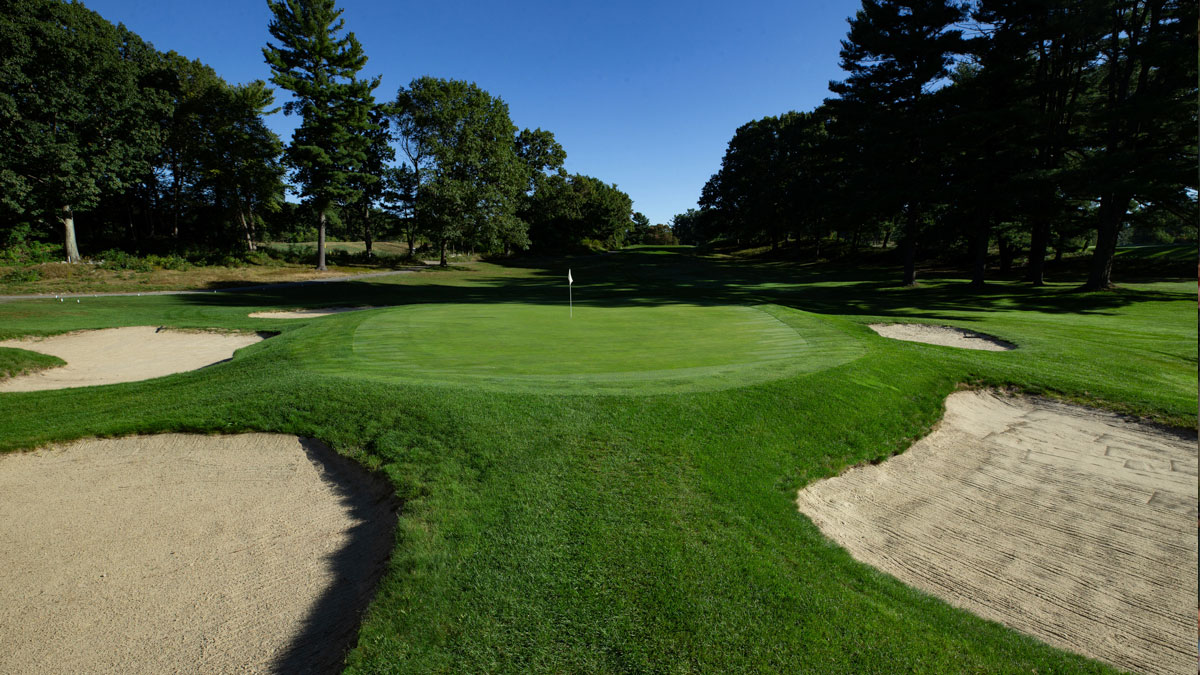
Meadow Brook’s founding members were largely young people, not exactly the norm for early-era courses. Ivy League students Clarence W. Brown and Walter P. Eaton started their search for suitable land, while high school students Frank Carter and Chester Brown identified farmland owned by Asa Parker. They also collaborated with Harry Nichols who built his own three-hole course with buried tomato cans, while a shopkeeper Emily Ruggles sold the hard rubber balls and clubs needed to play.
Together, five rudimentary holes were built on the old Parker pasture and opened to all Reading residents. Like many early courses, wire fences were put around the greens to keep the cows off the “tender grass.” In the first year, 30 members joined Meadow Brook, many of them women who were taking up the game in great numbers. Clubs were kept in an old hayloft, prior to Meadow Brook’s first clubhouse, which was built with rough spruce logs from Maine. Situated atop a pine-wooded knoll, it was considered one of the most picturesque clubhouses in the Boston area.
Soon after, the club leased more land for Alexander Findlay, who designed nearby Bear Hill Golf Club in Stoneham, to design the original 9-hole layout that is played today.
As mentioned in the intro, Meadow Brook hosted an amateur invitational in the early days before World War I. In November 1913, six weeks after the Brookline native shocked the world by winning the U.S. Open as an amateur at The Country Club, Ouimet arrived at Meadow Brook to face John G. Anderson, runner-up in the 1913 U.S. Amateur, in an 18-hole stroke play playoff. With the two even through 11, Ouimet pulled away with a masterful display down the stretch to win by 7 strokes. As the Boston Evening Transcript Reported, “While the Meadow Brook course is short, the distances were exceedingly deceptive, owing to the position of the sun, as the match started later. There [also] was practically no roll to the ball and the grass was rather heavy on the fair greens. Under these circumstances…the 77 by Ouimet was really first-class golf.”

Meadow Brook’s membership continued to grow following’s Ouimet’s victory. Another noted architect, Wayne Stiles, was brought in during the 1922 season to explore expanding the club to 18 holes. First, many holes on the 9-hole layout were lengthened, a new fifth hole (today’s sixth) was built, and several stone walls were removed from fairways. However, in 1928, the log cabin clubhouse burned to the ground, forcing the club to divert funds to rebuilding and refurnishing a new one.
Like many area clubs, golf struggled to catch on during Great Depression and lead-up in World War II. In 1937, torrential rain turned many of the sand traps into water traps, and in 1948, the clubhouse burned again.
However, fortunes turned around 1959-60 when the club sold its gravel that helped build nearby I-93, which passes west of the golf club. This helped finance a new course renovation by Geoffrey Cornish, who implanted many of the modern features seen today, including the current 5th and 6th holes (now a par-5) and the two-level tee boxes on holes 1 and 3. In 2005, the pond where the 3rd green, 4th tee, and 6th green converge was added during an irrigation project.
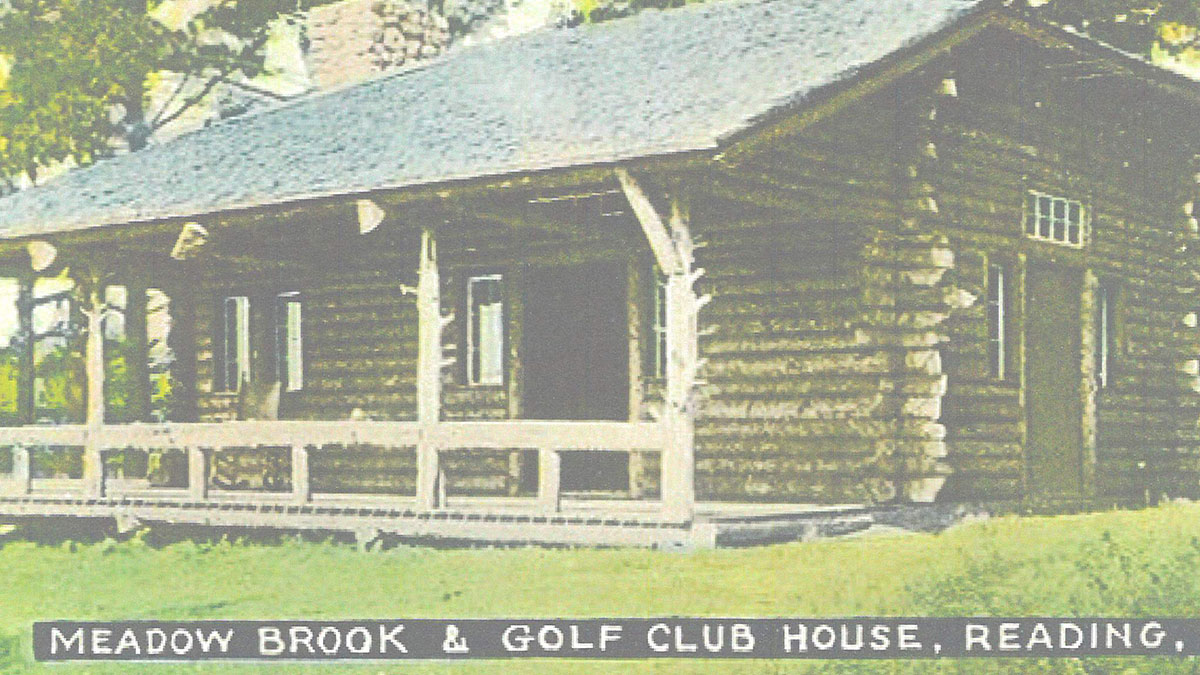
The challenging course has prepared many successful Meadow Brook members for competition over the years. Ralph Milley won the 1950 New England Junior Golf Championship, followed by the 1952 Mass Junior Amateur, with his 8&7 victory over Dick Grady (United Shoe) going down as the shortest final match in event history. Nearly 60 years later, he was recognized when he attended the 2021 Mass Junior Amateur at Indian Pond Country Club.
🏆 Former Champion 🏆
Ralph Milley won the Junior Amateur Championship 8&7 in 1952 at Commonwealth CC and he’s here today at Indian Pond to check out the action! 👏🏻👏🏻 pic.twitter.com/oCPZ3pPitM
— Mass Golf (@PlayMassGolf) August 6, 2021
In 1970, Frank Geremonte shot consecutive 75s to win the Mass Senior Amateur at Haverhill Country Club. The then-55-year-old Stoneham attorney quipped afterward that he was “an 80 shooter who had a couple of good days.” Dick Crosby won the same event in 1986 at Woods Hole Golf Club, fending off Gael Coakley in a two-hole playoff.
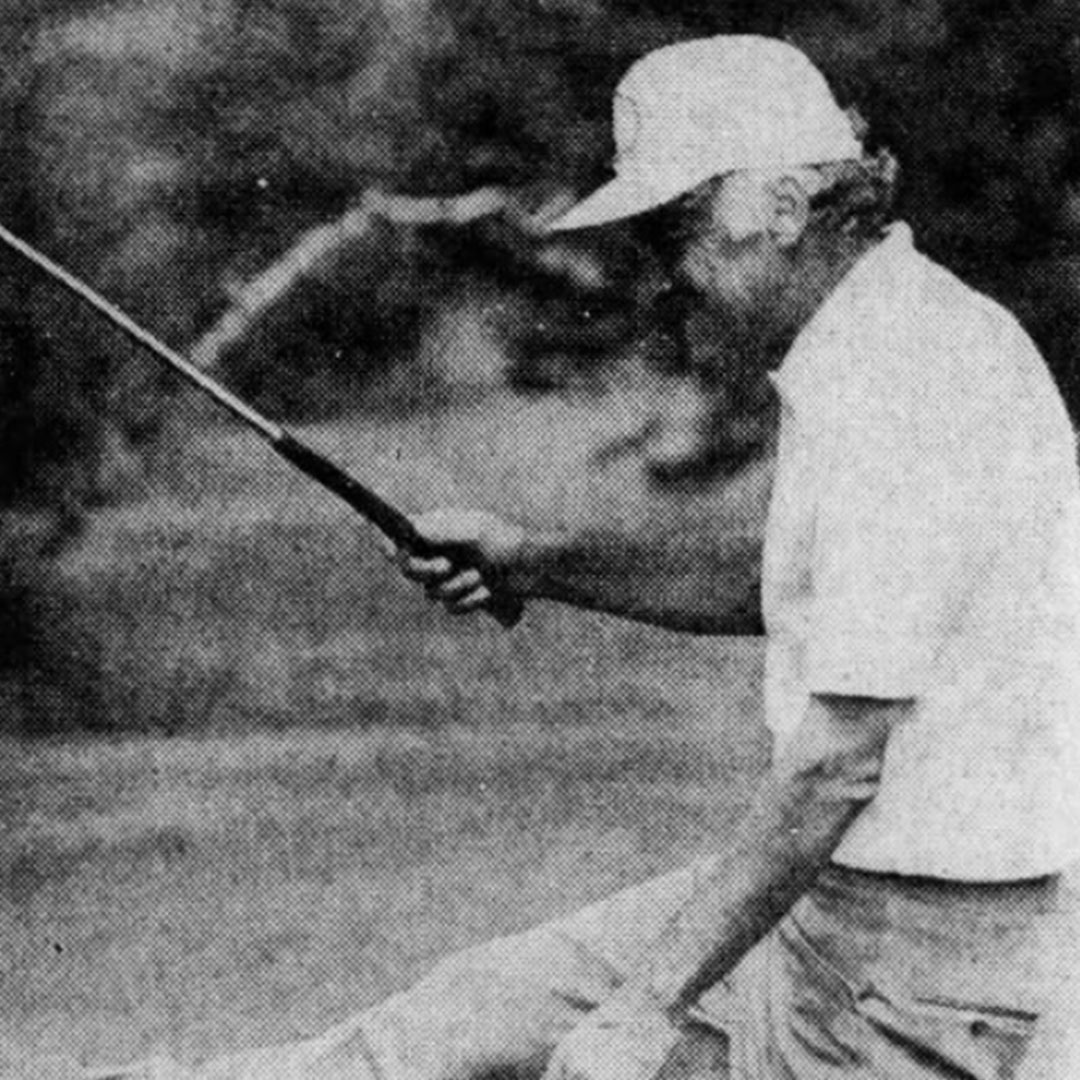
There’s also countless hockey figures that have belonged to the club over time. Brent Beaudoin, who currently plays for the Worcester Railers of the ECHL, has worked in the bag room. Longtime superintendent Rich Gagnon took several pictures included in this article, and he moonlights as a college hockey photographer. One of his photos on former UMass star Cale Makar was featured in last month’s addition of Sports Illustrated.
You also can’t tell the story of Meadow Brook without mentioning Clifton and Bernice Keane, who belonged to Meadow Brook for five decades. Clif covered the Red Sox for the Boston Globe, where he met Bernice, a classified ads writer. The two were married for 63 years, and in that span, Bernice earned more trophies than her husband, taking home eight women’s club championships.
“They loved playing golf together,” their daughter Jacquelyn Keller told the Boston Globe after her father’s passing.
Meadow Brook also saw its fair share of pro golfers over the years. LPGA pro Brittany Altomare, a Shrewsbury native, also left her mark on the course when she won the Mass Women’s Open in 2014. Playing on the Symetra Tour at the time, Altomare established a women’s course record with a final-round 69 to win by three strokes. Rick Karbowski, a two-time Mass Junior Amateur champion, holds the men’s course record with a 64 and has gone on to be a successful pro within the NEPGA ranks.
Locally, Mary Ellen Hurton was a Women’s Golf Association of Massachusetts board member for 10 years and served as Secretary, Tournament Chair and Chair of the Griscom Cup. She also won 17 women’s club championships between 1966-1998. Fellow member embers Jean Enright and Rick Finlayson went on to become golf pros at Holly Ridge Golf Club (Sandwich) and Franklin Country Club, respectively.
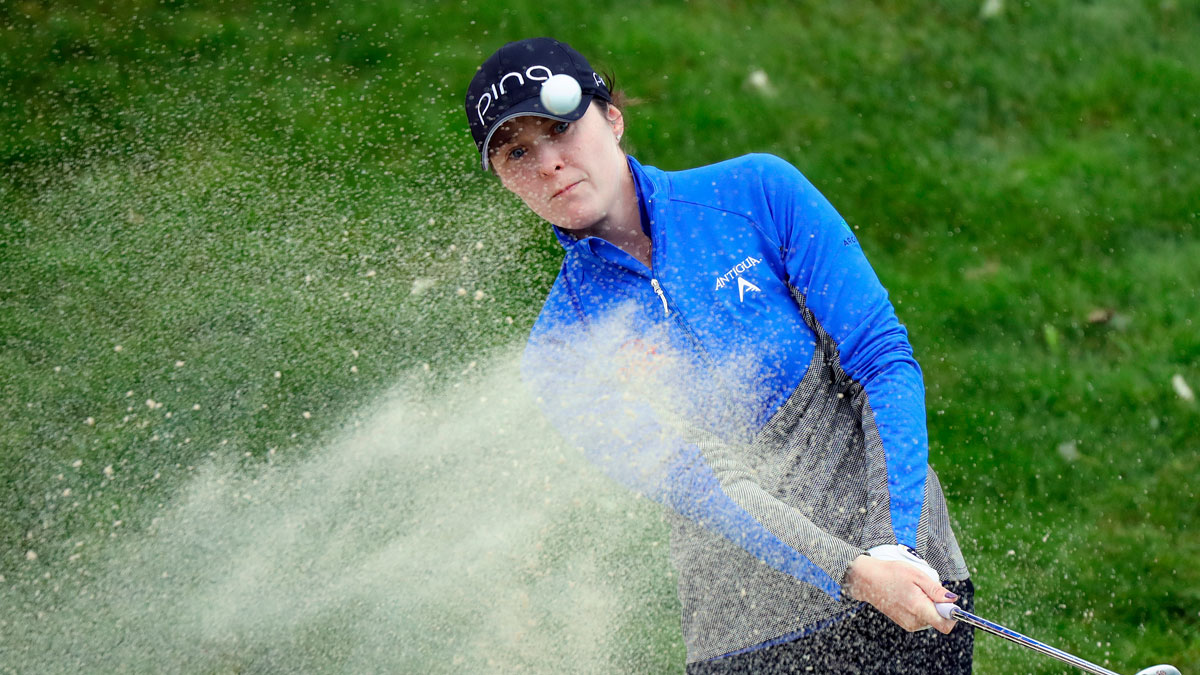
Nowadays, Meadow Brook is active year-round with TrackMan simulator technology inside and courts used for both tennis and pickleball, and a grill & tavern to kick back after a long day.
The Reading High School golf team also has some home-course advantage. This past fall the squad won all five of its home matches at Meadow Brook, and six out of seven the year prior.
The club has also raised hundreds of thousands for charity, hosting a Jimmy Find Tournament for years and a Breast Cancer Tournament for over 10 years. Last year the club brought through charity events $54K.
“Over the years the course has undergone major improvements with irrigation system, tree reduction program, expansion of a number of greens to restore them to the original size,” Brown said, “and recently a new short game area was added and expanded practice green.”
As part of its 125th celebration this year, Meadow Brook will be hosting the Mass Mother-Daughter/Member Junior on July 10, followed later in the day by the second annual Mass Golf Women’s Play Day, a team event designed for golfers who have never participated in a Mass Golf Event before.
What awaits them is one phenomenal and historic golf course.

Editor’s Note: Special thanks to Northampton Country Club historian Donny O’Brien for his assistance in compiling information for this story.
Starting out as a fifty-fifty cooperation between Smith College students & faculty and city leaders, Northampton Country Club has become one of the longest-lasting continuously operating golf clubs in Massachusetts west of the Connecticut River.
The 9-hole course, which finishes with the backdrop of one of the architecturally profound clubhouses in the state, has gone through several highs and lows in its history, but ultimately stands among the most storied golf venues in Western Massachusetts.
Nestled in the village of Leeds in the northwest corner of the city, the club has been limited to members and guests for most of its history. However, that changed in 2016 when new ownership introduced public tee times.
“The club has always had a strong, loyal membership,” said Jim Casagrande, the club’s head golf professional and co-owner with his wife Chrissy. “When I bought it, the intention I had was to keep the members we had, who are terrific, but supplement that with some public play. We’re trying to get it to be in terrific condition and be a place you don’t want to leave.”
With some added length introduced in recent years, the course can now be played from a range of 4,890 to 6,045 over 18-holes using combo tees.
The opening hole, a long par-5, starts with a picturesque drive from an elevated tee box toward a narrow, winding fairway that stretches for much of the length of the course. Holes 4 and 5 provide particularly difficult challenges as they loop through the Fairway Village condo complex. The 4th features a small fairway landing area that sets up a challenging targeted approach shot into the green. The fifth is a dogleg right on the other side of the condos, with forced carry up hill and over a creek.
“Those holes can hurt you, but if you can get by them unscathed, you can play well,” Casagrande said.
The 6th is a drivable par-4 that offers a shot at redemption from the prior two holes, while the 7th and 8th are back-to-back par-3s (the only ones on the course) that’ll also test your short game.
The closing hole, which can now play as far back as 475-yards, has open space to the left, but any miss off the tee to the right is trouble. Aside from a couple greenside bunkers, not much danger lurks. However, with a large amphitheater and a two-story deck overlooking the closing hole, you’re likely to have a gallery watching your final shots during the busy season.
Who designed this layout still very much remains a mystery. When new land was acquired in the early 1910s, Donald Ross, who was the head pro at Essex County Club at the time, visited the club. According to an article from the Daily Hampshire Gazette in September 1911, “land has been surveyed, and Mr. Ross took a plan of the grounds with him from which a model course plan will be drawn.” However, there is no record of Ross ever returning to the property.
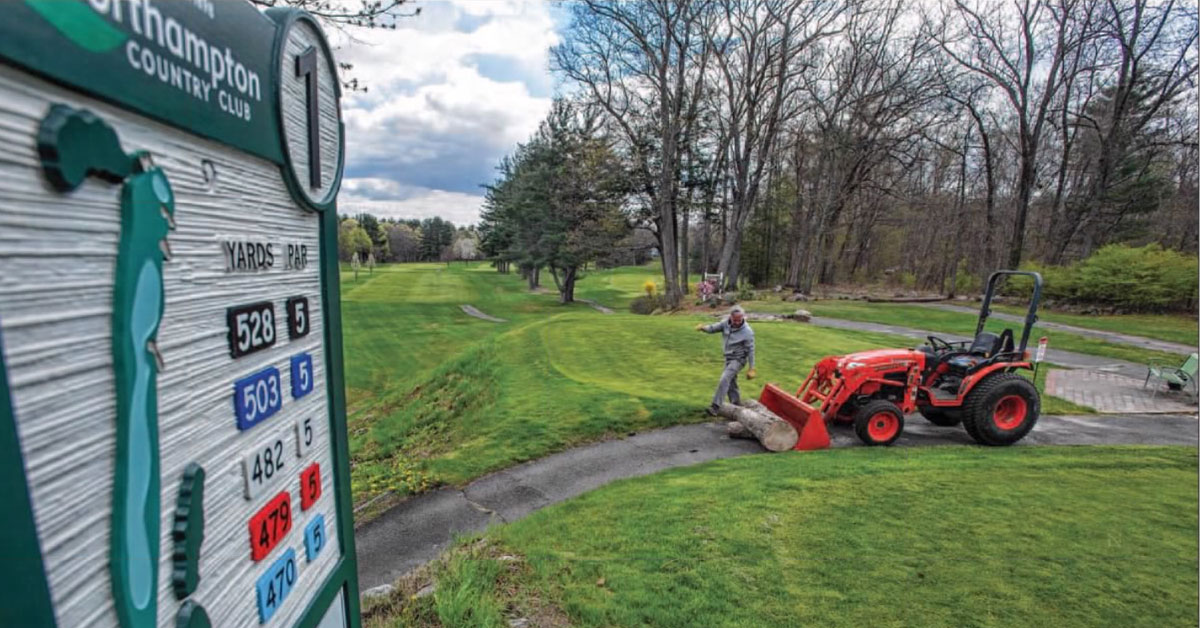
Smith College has always been on the forefront of women’s athletics. The largest member of the historic Seven Sisters colleges was the site of the first women’s college basketball game in 1893 and interest in athletics skyrocketed in the years following, golf included. Needing space outside of downtown Northampton to play the game, the club got its start as Warner Meadow Golf Club in 1898, the site of the present day Look Park (adjacent from the current site on the other side of the Mill River).
The location was selected specifically as it was steps off the Williamsburg electric car line allowing easy access for community members. The club leased 100 acres from Arthur and John Warner for $250 per year. Membership was $8 men; $4 women. Golf was forbidden on Sundays.

For the first decade, the club was a smashing success, with croquet and tennis offered in addition to golf and a new enlarged clubhouse in 1904. The Daily Hampshire Gazette reported that the club “has had a longer life and more prosperity than any other similar institution existing in Northampton.” However, by 1908, members grew tired of negotiating with the Warners who wanted a 20% annual increase in the lease. As a result, on April 23, 1908, the club reestablished itself as Northampton Country Club and shifted the club to about 45 acres of land across the Mill River, where the current course exists.
Ralph Parsons, a legend among Northampton members, became the club’s greenskeeper in 1924 and held that role for 50 years. When he started, there was no tractor, instead he relied on a horse named Jim to keep the fairways in shape.

In 1960, Northampton Country Club constructed a 23,000 square-foot swimming pool, making the club more enjoyable to an entire family. During that time, there was desire to expand to a full 18-hole course, but the members who preferred to erect a new clubhouse won out. An unusual design by architect Gordon Wiedenkeller, the new clubhouse was brought to life by contractor Frederick J. Ostrowski. The large banquet facility hosts weddings throughout the year, and there are now two simulators inside to enjoy golf year round.
The course has been rerouted and reshaped often. The 9th green, which is larger than the rest, used to be a double green for the 3rd and 9th holes. In the 1980s, condos were added near the property, forcing the 4th and 5th holes to be reshaped to fit into the shifting landscape.
NOTED NAMES
You can’t tell the history of Northampton Country Club without the Toski family, specifically Massachusetts Golf Hall of Famer Bob Toski. He was the youngest of his brothers — Jack, Benny, and Tommy — all of whom became golf professionals in the area. Benny, who became NCC’s pro, made miniature clubs for his brothers, who became excellent putters when they got older.
Bob Toski elevated the family name to the national stage when he played on tour from 1948 to 1957. A slender Toski who was nicknamed “Mouse” by Sam Snead won five times on tour, with his four wins in 1954 making him the leading money winner that year. He left the tour at age 30 to spend time with his young family but found success as a golf instructor and author. He became the first living instructor inducted into the World Golf Teachers Hall of Fame.
In 1935, the club welcomed “The Squire” Gene Sarazen and Babe Didrikson Zaharias, one of the greatest female athletes of all-time for a match-play exhibition featuring Benny Toski and Greenfield’s Mac Sennett. Playing in front of a gallery of about 400, Sarazen shot an even-par 70, while Zaharias shot an 84. Toski shot a fine 72 and Sennet’s 77 included just enough winning holes to secure a tie for the locals.
In the late 1940s, Patty Berg, whose 15 major wins still leads all women in professional golf, played exhibitions at Northampton Country Club. In 1969, the Patty Berg Classic was played at Pleasant Valley Country Club in Sutton, with all-time wins leader Kathy Whitworth (88 total pro victories) earning the title.
You may not recognize the name Warner Oland; however, he played the famous role of Honolulu Police detective Lieutenant Charlie Chan in 16 films. Oland married playwright and portrait painter Edith Gardener Shearn, a Northampton native, and often could be found playing the Warner Meadow course when it was still open. Oland died in 1938, and is buried at Southborough Rural Cemetery, which is fittingly adjacent to Southborough Golf Club.
More locally, the Rolland family women have been stalwarts in Northampton’s history. The family grew up on Spring St. abutting the sixth green and captured 38 club championships combined. Martha Rolland Hayes was the most accomplished of them. She won her first women’s club championship as a high school senior in 1943, the first of 28 golfing crowns she earned over the course of six decades. Today’s the Martha Hayes Ladies Open 2 Ball is among the most popular event for the ladies.
Other longstanding club event include the Memorial Day Member-Member, which began in 1948, and the Ralph Parsons Four-Ball on Labor Day weekend, which dates back to the early 1970s and honors the service of its longstanding groundskeeper.
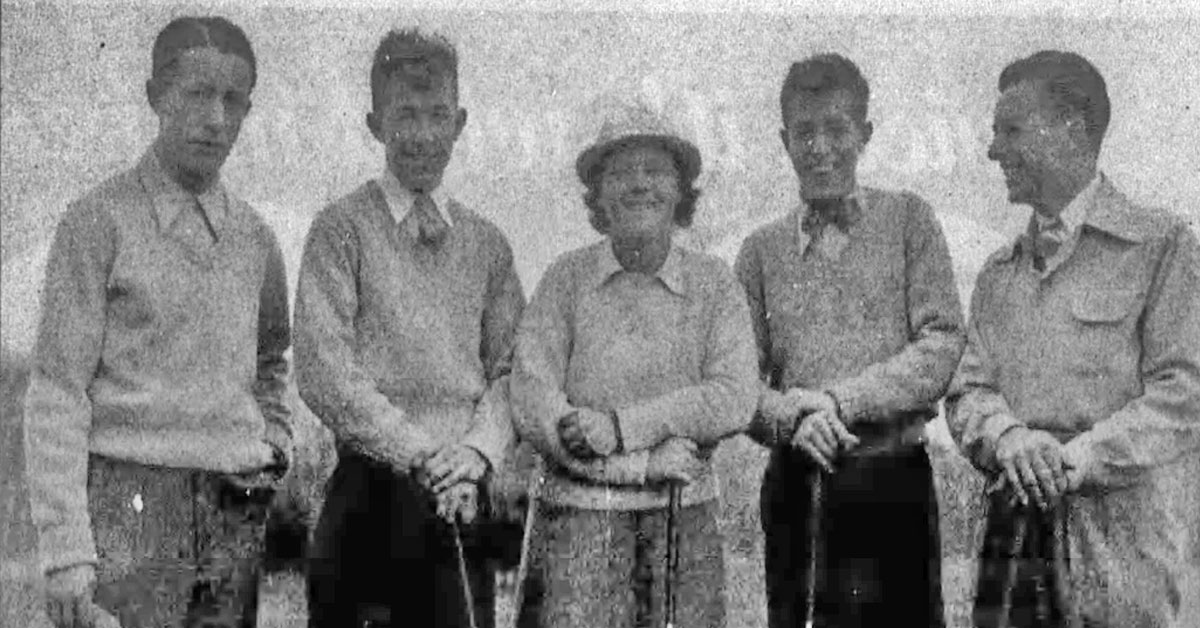
While the course changed hands many times from the 1980s to present, a new chapter is currently being written under the ownership of the Casagrande family. Jim and Chrissy’s daughter Anna Casagrande grew up playing the game here, and she recently competed for the inaugural Bryant University women’s golf team. The course also remains the home of the Northampton High School golf team, one of the top programs in Western Mass. It also has a lively atmosphere and food and beverage options are a hit for the club.
“We want to keep improving the product,” Casagrande said. “We have the mindset of bringing this back to what I want it to be: a 9-hole gem that everybody is proud of.”
Those looking for a sign of an optimistic future should look no further than Chris Carey, a 22-year-old maintenance worker at Northampton CC. Prior to 2022, Carey played in the club championship but had finished last three times. But 2022 was different. This time, Carey made the final foursome that included two past champions. Despite a brutal start, that included three bogeys and a nine, Carey rallied back to hit the next five greens in regulation, winning by one stroke and completing a worst-to-first turnaround.
Not to be outdone, on June 9, 2020, Kevin Cahill, Dede Johnson and Brian Cleland all aced the par-3 8th within 90 minutes of one another, an astronomically-rare feat.
Their stories may not carry the weight of the history the Toski and the Rolland families brought to the club. However, when you truly wonder what has kept Northampton Country Club going all these years it is a legacy of motivated individuals who never gave up and kept coming back with the hope that one day something truly special might come of it.
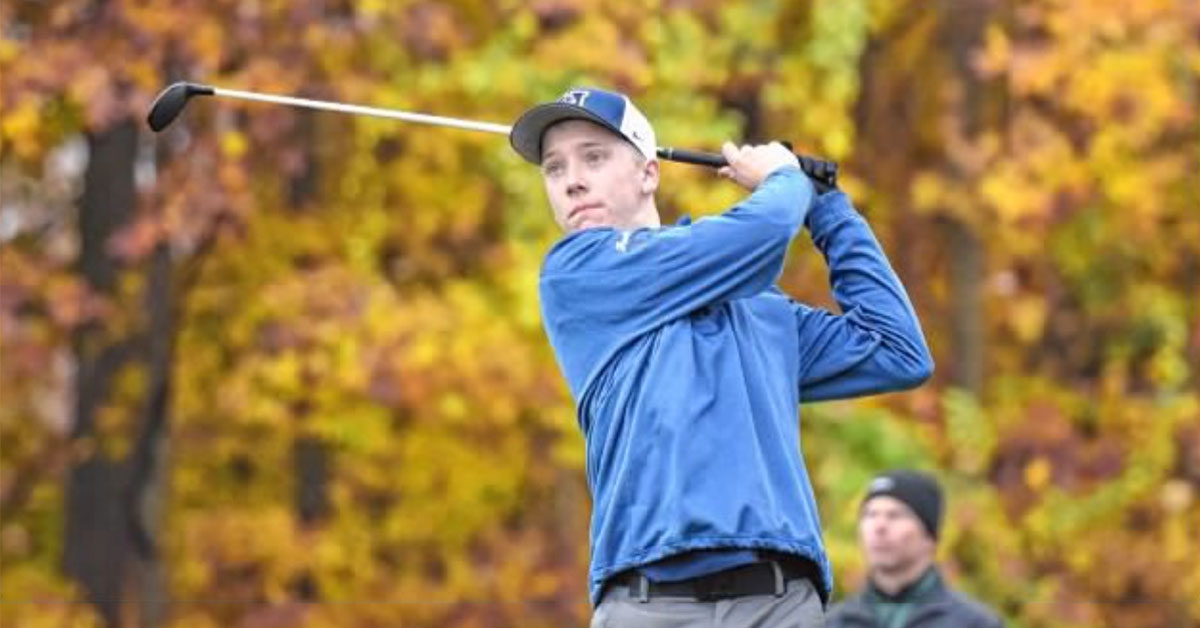
Over the past 125 years, Sharon has evolved from a sleepy town within the Greater Boston area to a bustling suburb along I-95 between Boston and Providence. Yet in that same span, time has stood relatively still at the town’s first golf course, which remains one of the oldest in the region.
Golf got its start at Sharon Country Club (not to be confused with the Cape Club of Sharon) in 1898 when three holes were laid out on the pastures of a dairy farm owned by George O’Leary. Fittingly, the cows then were responsible for the turf care, and there were fences to keep them from wandering onto the greens. In 1914, nine men formally organized Sharon Country Club, with a stated purposed of maintaining golf links, tennis courts, and owning, establishing and maintaining a place for social meetings.
Nine years later, the club officially purchased the property from the O’Leary family and began the process of shaping much of the course as it stands today.
The private club is tucked within the trees a short drive from downtown. It currently has 10 holes used for regular play, most of which were designed by Wayne Stiles and his partner John Van Kleek, who joined Stiles in 1924 and designed several courses up until the Great Depression began in 1929. Stiles is also known for designing nearby courses such as Thorny Lea Golf Club, Pine Brook Country Club and Marshfield Country Club.
Sharon features several small circular and egg-shaped greens that have been largely untouched since they were built (Holes 1-6 & 9). True to Stiles’ form, players often hit to elevated greens with bunkers ready to swallow up errant approach shots. The first green, for example, is a 30 paces wide, requiring precision to land safely on it. The club uses a different finishing hole for each nine, with the course’s 10th hole being used as the 18th. From the white/blue combination tees, it plays at 6,583 yards to a par of 72.
Paul Doherty has tended to the course as the head superintendent since 2002, doing his best to keep the conditions firm and fast and maintain the course’s beautiful mounding around captivating native areas.
“You can see the history of the club when you go play,” said Brian Hayes, the head golf professional at Sharon Country Club. “We’ve got the rock walls since the 1920s, and remnants of above-ground irrigation systems used throughout the years.”

Brian Silva and Geoffrey Cornish have done renovation work on the course, but it maintained the same nine holes until the turn of the century when three more holes were added. There were also plans to expand to 18 holes, however, the club membership put a greater emphasis on building a new clubhouse and making room for a driving range and a short-game area.
One of the original Stiles holes, the par-3 8th, which played about 170 yards over a large pond, was among those replaced. Similar to how the 11th hole at this year’s U.S. Open at The Country Club was re-introduced for the championship, Hayes said each year he’ll hold a few tournaments featuring the original 8th hole. One of those is a par-3 tournament, where temporary tees are introduced in the middle of fairways. Between glow-ball night tournaments, league play, and the ever-popular three-day member guest, there’s plenty of fun, organized golf taking place at this club throughout the year.
Hayes said there’s members with friends who belong to Norton Country Club and over the past decade-plus members from both clubs have joined together for a four-ball match play event playfully referred to as ‘The Shnorton’, a portmanteau of the two clubs.
“There’s always a trophy on the line for the winning club,” said Hayes, who became head pro in 2015.
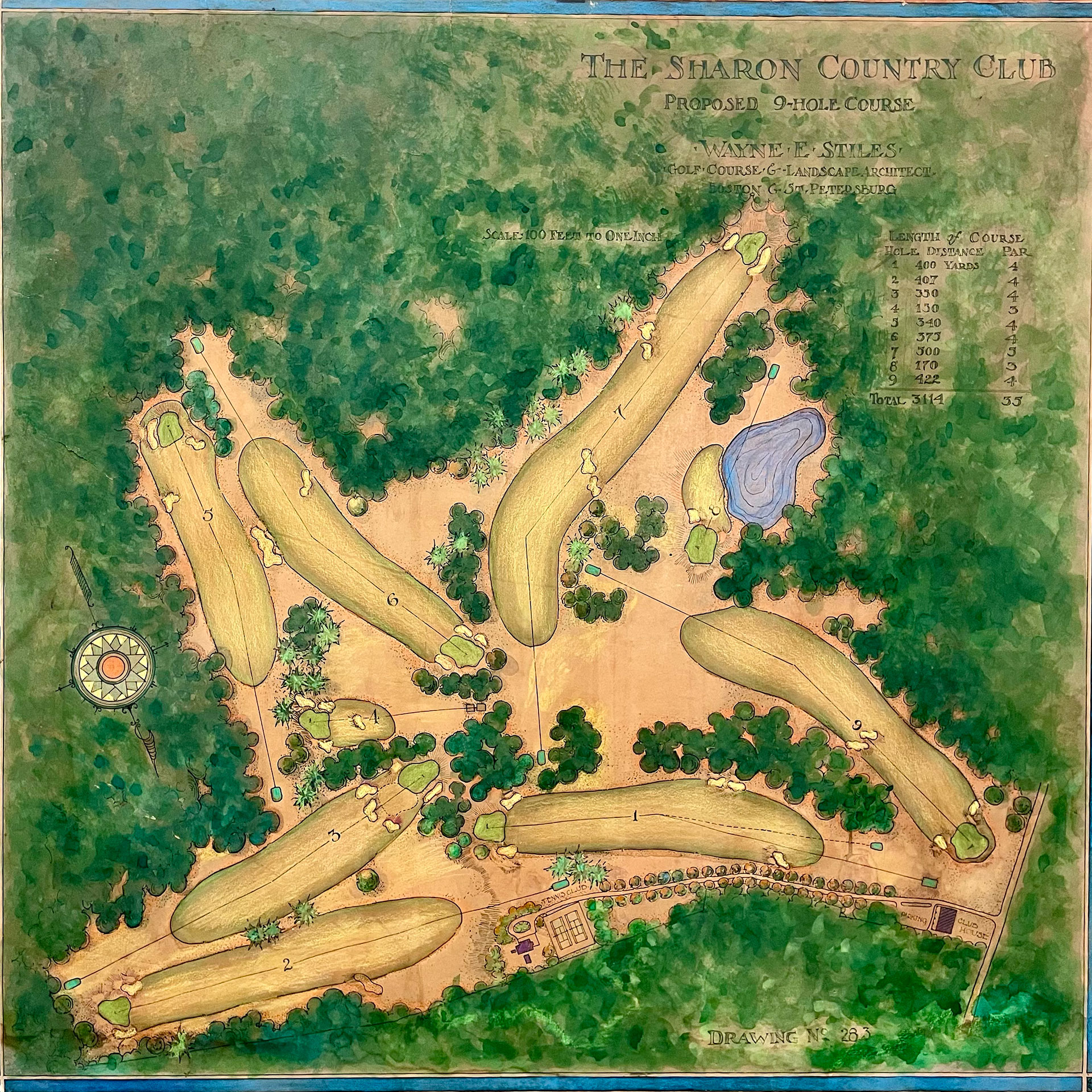
One of the first high-profile golfers to play the course was non-other than Francis Ouimet. On July 29, 1928, a large gallery arrived on-site to watch the 1913 U.S. Open champion team up with his older brother, Wilfred Ouimet, and play a four-ball exhibition match against Ray Ouimet, the younger Ouimet brother, and club president Hamilton Mansur. Wilfred and Francis won the match, 2-up, despite Mansur shooting 74, edging out Francis by two strokes.
The Kirouac family also brought tremendous pride to Sharon Country Club as Walpole native Ed Kirouac won the 1932 Mass Amateur Championship at Kernwood Country Club and turned pro in 1938. Kirouac became the head pro at Sharon in 1946 where he stayed for 20 years. At just 13 years old, his son Robert qualified for the 1956 U.S. Junior Amateur at Taconic Golf Club, an event that featured Jack Nicklaus. Robert also made it to the final of the Mass Amateur in 1963 and 1967.
The club community also came together in 1954 when Sharon Country Club made the bizarre move of joining the Western Golf Association, made up largely of golf clubs from the Midwest. But they did so to support one of its young members, Russ Wallace. At 18, Wallace was a promising young golfer but didn’t have the funds to attend college. But with a $35 investment by all members, Sharon was admitted to the WGA, which allowed Wallace to apply for the Chick Evans Golf Scholarship, the nation’s largest scholarship program for caddies. Wallace was then accepted into Northwestern on a full scholarship. (Nowadays, the Francis Ouimet Scholarship Fund and the Evans Scholars Foundation annually co-sponsor a handful of scholarships for caddies from Massachusetts.)
By the 1990s, access to private clubs in Greater Boston were in high demand, with many initiation fees surging into five figures. While Sharon never had a reputation for being an easy club of be admitted to, a 1997 article in the Boston Globe included Sharon as among clubs that are, “one of the best bargains for golfers looking for a private place to play,” listing initiation at $2,000, and annual dues at $1,000.
“It was still a hard place to get into,” Hayes affirmed.
Currently, Sharon Country Club stands at about 300 members and a couple dozen individuals on the waiting list. The club opened a brand-new clubhouse on Super Bowl Sunday in 2020, replacing the previous dairy barn that served as the clubhouse from 1923 through 2019. With new locker rooms, a fresh bar area, and a patio overlooking the first tee, it’s a comfortable place to relax after a round of golf.
Plans are still being discussed for the 125th anniversary, but in the meantime having a classic course with new investments in facilities help ensure the club can continue to foster a strong community and celebrate more anniversaries down the road.
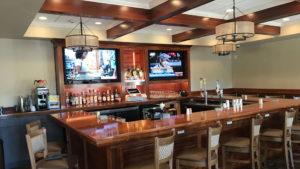
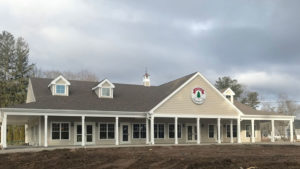
Mass Golf is a 501(c)3 non-profit organization that is dedicated to advancing golf in Massachusetts by building an engaged community around the sport.
With a community made up of over 110,000 golf enthusiasts and over 340 member clubs, Mass Golf is one of the largest state golf associations in the country. Members enjoy the benefits of handicapping, engaging golf content, course rating and scoring services along with the opportunity to compete in an array of events for golfers of all ages and abilities.
At the forefront of junior development, Mass Golf is proud to offer programming to youth in the state through First Tee Massachusetts and subsidized rounds of golf by way of Youth on Course.
For more news about Mass Golf, follow along on Facebook, Twitter, Instagram, and YouTube.